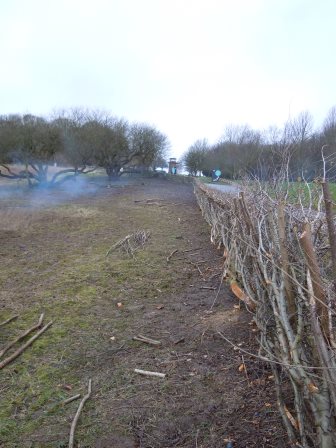Working with Volunteers

By Derrick Hale, Assistant Hedgelaying Secretary of the Brailsford and District Ploughing and Hedgecutting Society
A notable amount of hedgelaying is carried out by volunteer groups, from conservation, environmental, countryside ranger and other organisations. Here are some of my experiences of working with such groups.
Volunteer groups are usually comprised of people of both sexes, with
a range of ages, a range of life and work experiences and with a range
of physical abilities. Individual motivation for joining a volunteer
group varies too and can include simply enjoying being outdoors, through
wishing to maintain fitness, to perhaps being involved in a long term
project for example canal or railway restoration. I have found
hedgelaying to be a very popular activity with the volunteer groups I
have met and worked with.

Some practical problems tend to arise regularly with volunteer groups. One is the "dilution of skills" process in which training is given by persons who have received limited training themselves. As time goes on and this process continues, person to person, the basic principle of hedgelaying, if learned in the first place, can be lost.
Another familiar problem is that of tool sharpness, tool maintenance and even lack of provision of the correct tools for the job. The essential tools for hedgelaying are the axe and the billhook. So often with volunteer groups the tools arrive in a box or bag, the billhooks never having been sharpened properly and only ever rubbed over with a dry carborundum stone. I have found that axes, which have suffered the same fate, are often in short supply. A result of this is that the volunteers become frustrated and pick up the only sharp tools available, bow saws, pruning saws and loppers and the result of this, combined with loss of basic principles, is side branches disappearing and stems being sawn into at right angles to the grain and split back. The latter, for me, has nothing to do with hedgelaying and cannot be justified in terms of the health and regrowth of the hedge.
The above is starting to sound rather hopeless but all problems can be resolved. With regard to training one option is to put volunteer groups in touch with local experienced trainers and the local hedgelaying societies which run courses. Another option is to invite members of organisations which employ volunteers on to the NHLS/Landex Train the Trainer courses. My experience indicates that some sort of further top-up or updating courses are valuable.
As a trainer working with a volunteer group it is vital to be clear about the basic principles of hedgelaying and to keep reinforcing these. My personal basic principles criteria has three parts 1. Building a living stock proof barrier, or where stock are not kept, a living fence 2. Cutting to promote growth from the base of the hedge 3. Laying the hedge in the appropriate regional style. I can, in specific circumstances be flexible on the third point and I can add "should look good" on the basis that if it looks right it is right. I find that encouraging volunteers to build a hedge can be difficult as there is often a drive and focus to make cuts and get the stems down. This goes back to understanding the principles - hedgelaying is not about dropping material on the ground but about building a living, working structure.

Working side by side with volunteers the principles and methodology can be taught. By encouraging visits back to the hedge to see the progress of regrowth makes sense of these to all.
The blunt tool problem can also be overcome. Organisations employing volunteers will usually have a workshop, somewhere. Otherwise a full time member of staff or volunteer might take an interest in this side of the work. Regarding other tools someone with a chainsaw certificate can be very useful but care needs to be taken to ensure that the chainsaw is not over used.
All the members of a group of people with mixed experience and mixed abilities, as described at the start of this article can be involved in a hedgelaying task. Not everyone will have the physical strength needed to carry out all the elements of hedgelaying, or the required stamina but there are other jobs to do, for example stake sharpening, clearing brash, or feeding the bonfire (an inevitable volunteer group feature). Rotating roles can give everyone a chance to try their hand, develop new skills and give them ownership of the finished result.
With regard to the finished result this can be a source of satisfaction and pride for the volunteers who have layed a hedge. Almost everyone appreciates the aesthetic appeal of a layed hedge, the straight lines, the consistent angles, the way it fits so well into its surroundings, its clear function. Then there is the satisfaction of a product resulting from hard work, for nothing is easy in hedglaying.
The hedge shown in the attached photographs was layed by a volunteer group, the members of which can be justifiably pleased with their efforts.
Contact Derrick on d.hale054@btinternet.com for information.
Updated information October 2021:
http://www.brailsfordploughingmatch.org.uk